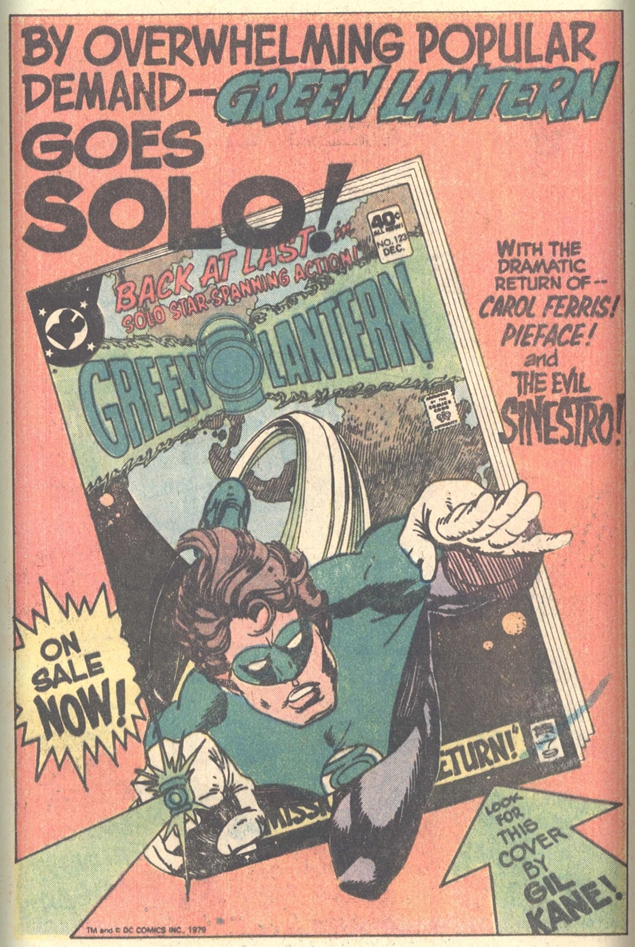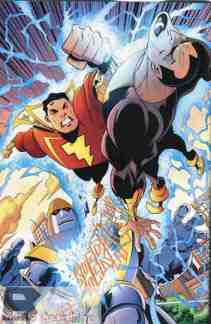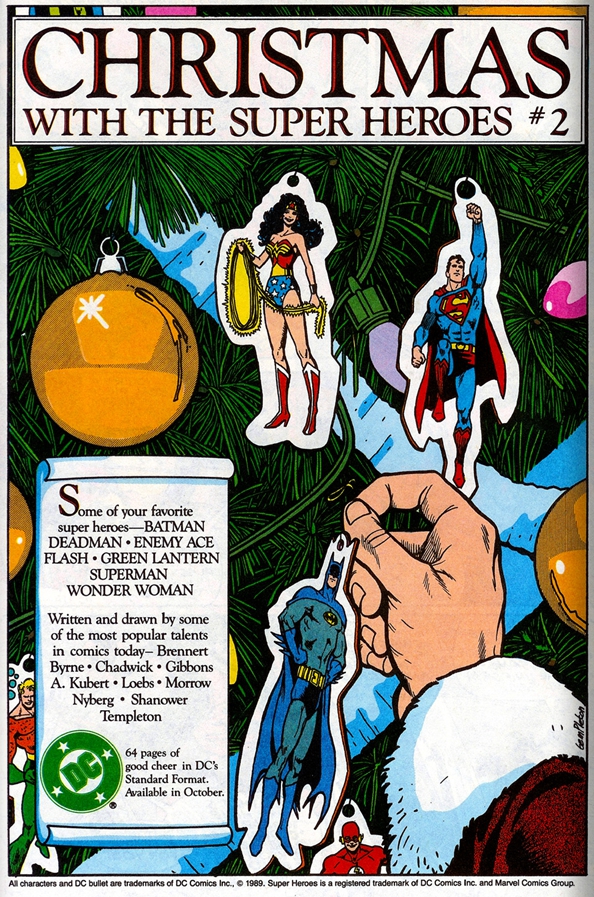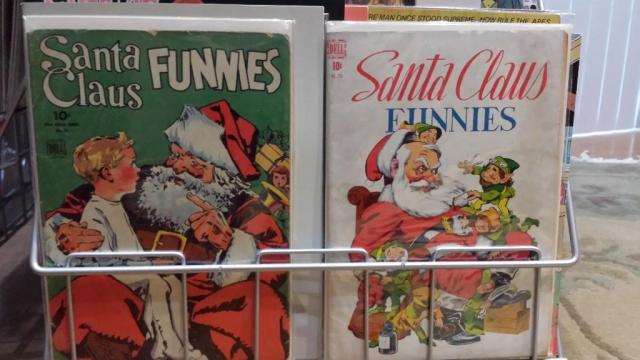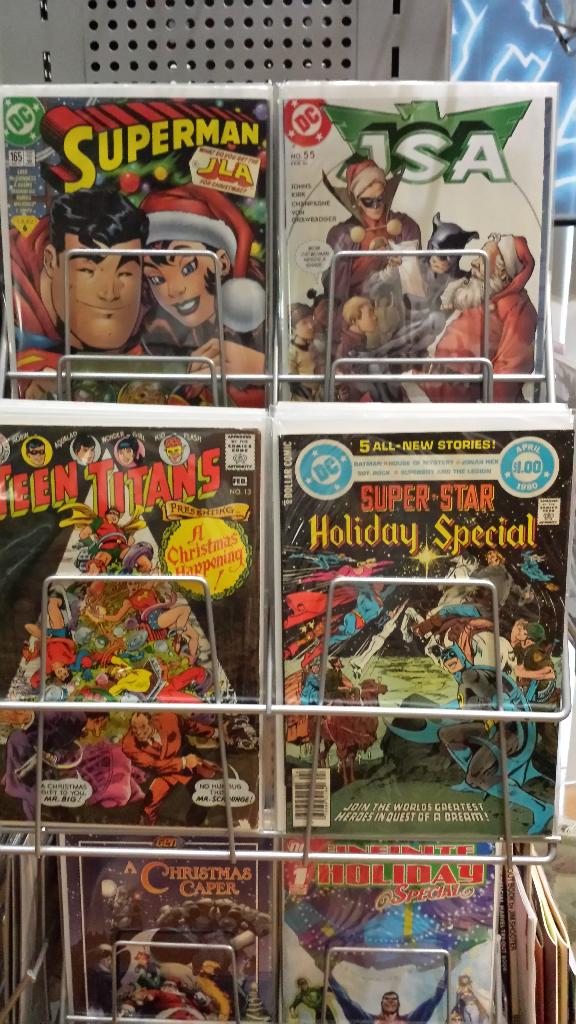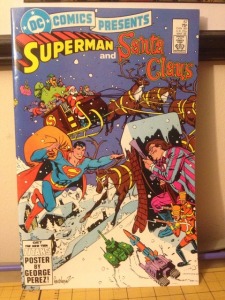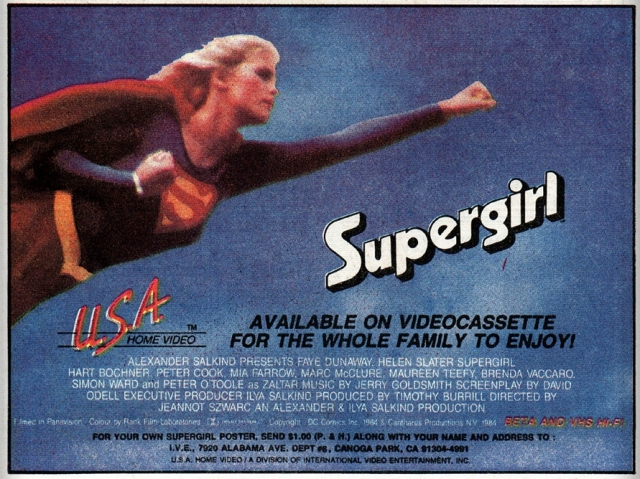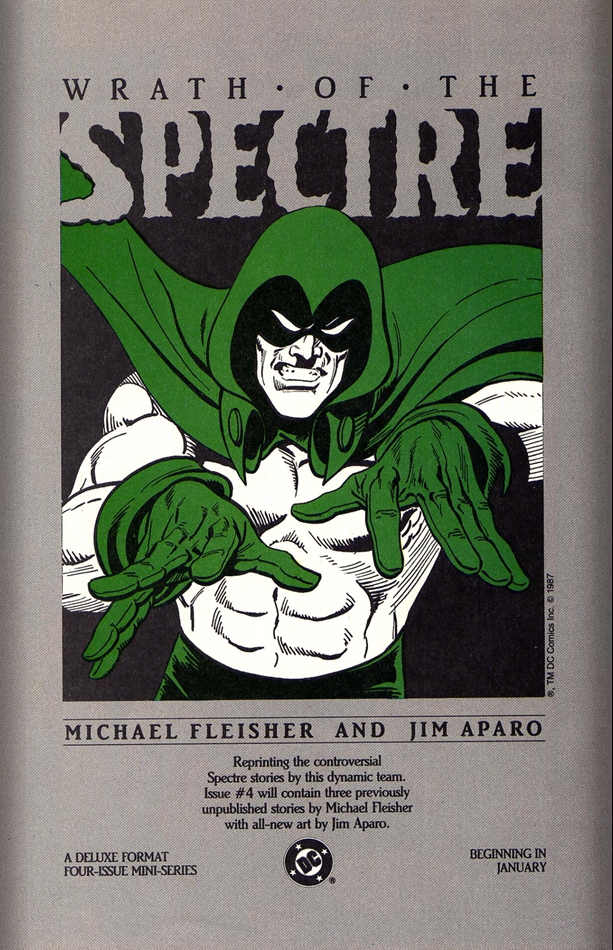
In 1988, based on the renewed popularity the Spectre was receiving thanks to his 1987 ongoing series written by Doug Moench, DC comics decided to reprint the Spectre’s ‘controversial’ stories that ran during 1974-1975 in Adventure Comics. Wrath of the Spectre reprints Spectre stories from Adventure Comics #431 to #440 and three additional Spectre stories (that never saw print) in a 4-issue deluxe format mini-series. The creative team responsible for the Adventure Comics Spectre stories were Michael Fleisher (writer), Russell Carley (art continuity), Jim Aparo (art), Frank Thorne (art) and Joe Orlando (editor). These stories were considered controversial as editor Joe Orlando was trying to push the limits of the Comics Code as far as he could.
A little bit of context: The Comics Code Authority was formed in 1954 as an indirect reaction to a book by Fredric Wertham called Seduction of the Innocent which claimed that scenes of graphic violence, sex, and drug use within comic books encouraged similar behavior on impressionable youths. During the late 1940s and early 1950s it was not uncommon for a comic book to have scenes of graphic violence (real or implied) since horror and crime comics dominated the comic book market. One of the comic book companies to be hit the hardest was EC Comics (known for classic horror and crime titles such as Tales of the Crypt, Vault of Horror, The Haunt of Fear and Crime SuspenStories). EC Comics went down in a blaze of glory and fought tooth-and-nail to print the material they deemed fit – Comics Code Authority be damned. EC Comics eventually went bankrupt and was sold to DC Comics. Why is this relevant? Because Orlando’s comic book career (first as a penciller and then as an editor) started at EC Comics. You see, Orlando had vast experience working with horror titles (ex: EC Comics, Warren, and Atlas comics) and while Spectre wasn’t a horror character per se – it sure seemed that way based on his original stories.
The Spectre was created by Jerry Siegel and Bernard Baily and first debuted in National Allied Publications’ More Fun comics #52 (1940). It was speculated that Siegel, who also co-created Superman prior to creating the Spectre, was influenced by the success of Gil Kane and Bill Finger’s Batman (published in 1939) and decided to create a darker, grimmer super-hero. When the Spectre first debuted, he was the ghost of a slain cop whose modus operandi was to hunt down murderous criminals and mete out brutal supernatural vengeance. Additionally, the Spectre also fought other mystic beings that were just as powerful as he was. The Spectre was popular enough to become a chartered member of the Justice Society of America in All Star Comics #3 (1940), and then suddenly the Spectre stories were toned down drastically – starting with the introduction of Spectre’s new bumbling sidekick in 1941: Percival Popp the Super-Cop. Once DC realized that the introduction of sidekicks helped sales of a book (ex: Batman and Robin), nearly every DC hero was assigned one. Unfortunately, the Spectre was relegated to keeping his bumbling sidekick out of harm’s way – which pretty much killed the eerie supernatural tone of the series first established by Siegel. The mid-1940’s were not kind to super hero comics as their popularity had waned and other genres of comic books (ex: war, western, science fiction, romance, crime and horror) had become the big sellers. The Spectre was last seen in All-Star Comics #23 (1945) before he slipped into ‘comic book limbo’.
Fun Fact: The Spectre story in More Fun Comics #52 had the first appearance of DC’s version of God in the story.
Gardner Fox and Murphy Anderson revived the Spectre in 1966, thanks to the guidance of editor Julius Schwartz who had been systematically reviving and updating all Golden Age heroes (ex: Flash, Green Lantern, the Atom, Hawkman, etc) for a new generation of comic book readers. This newly introduced Spectre was a watered-down version of the original, who now apprehended villains and delivered them to the police instead of slaying them. Furthermore, this new Spectre really played up the “battling powerful cosmic villains” aspect of the Spectre mythos.
In 1972, under the direction of editor Joe Orlando (who was also editor for DC’s House of Mystery), Adventure Comics was gradually shifting from the superhero genre to the supernatural/fantasy adventure genre. By this point the Comics Code Authority has loosened it’s censorship and horror comics were able to get away with more – which is why the market was suddenly flooded with horror titles again. Orlando was experienced with horror comics and it was a genre he was familiar with, he just needed a superhero he could feature in Adventure Comics who could also be played as a horror character – enter the Spectre. Fleisher was chosen as the writer for the Spectre based on his previous experience writing horror/suspense stories and his knowledge of Golden Age DC characters (Fleisher researched and wrote all 3 volumes of The Encyclopedia of Comic Books Heroes). Fleisher was insistent on capturing the original ‘vengeful’ essence of the character (as introduced in the early Jerry Siegel stories) rather than the cosmic champion he was portrayed as during the 1960s in the Gardner Fox stories.
The reason this series was so controversial (at the time) was because the audience of the 1970s were not accustomed to super heroes killing villains. The only other Spectre stories the audience would’ve been familiar with were the Gardener Fox stories of the mid-to-late 1960s in which the Spectre conformed to the “super heroes never kill” rule. It may not be the fact that the Spectre killed criminals that was so appalling, but the manner in which he did it (ex: turn them to wax and have them melted, turned to wood and hacked up with an ax, etc) and the fact that it seemed like the Spectre took pleasure in it. In truth, the creative team was actively trying to recreate the spirit of the EC horror comics of the 1940s, but the comic readers of the 1970s probably would not have been aware of that. Joe Orlando was researching the Comics Code, finding out what he was not allowed to do, and then doing it anyways thanks to some loophole in the Comic Code guidelines (you’ll notice that all of the Adventure Comics issues featuring the Spectre have the Comics Code Authority seal on them). A few readers wrote in to state that they were uneasy with the idea of a super-hero delivering vengeful justice, and a new reporter-type character who represented their views on the Spectre was introduced to the series. The most notable thing about this controversy, however, is that most of the outcry against this series came from within the comic book industry – fan-oriented writers and assistant editors were upset that a super hero character was getting the horror treatment and boldly stated that Orlando, Fleisher and crew were ruining the “American Super-hero”. It was rumored that a combination of DC’s apprehension towards the “controversial” content of the series and dwindling sales were the reasons the feature was cancelled and replaced with an Aquaman feature instead (Adventure Comics #441).
I really enjoyed this reprint series. The coloring is absolutely beautiful and brings Jim Aparo’s illustrations a lot justice. I don’t think anyone can do swooping and swirling capes quite like Aparo. I always liked the Spectre, but only knew of him from whatever I read during All-Star Squadron, so I never really understood his powers as they were never fully explained. Is he omnipotent? Just how powerful is he? This reprint series didn’t answer any of these questions, as he seems to be invulnerable and can’t be harmed by anything. The stories all kind of followed the same formula: a murder/crime is committed, detective Jim Corrigan is on the case, the Spectre catches up to the killers and they meet a gruesome supernatural death at the hands of the Spectre. The stories were pretty self-contained – very much the same approach you’d find in a horror anthology comic. The last three unpublished stories started adding continuity, and that seemed like a step in the right direction.

